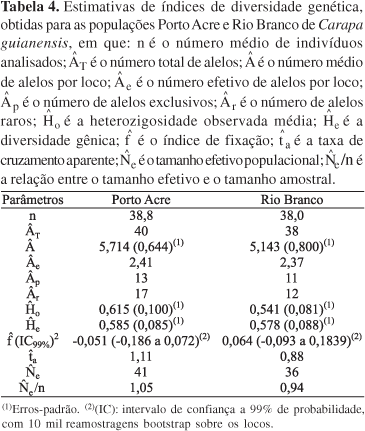The objective of this work was to evaluate the genetic diversity of two Carapa guianensis Aubl. (crabwood) populations, in the State of Acre, Brazil, and to compare the diversity estimations with those obtained in other populations of the species (in Brazil: Flona Tapajós, PA, Porto Acre, AC; and in Costa Rica). Seventy-seven individuals were assessed using seven polymorphic microsatellite loci. Fifty-one alleles were observed in the two populations, in which the effective number of alleles per locus (Âe = 3.2) was lower than the average number of alleles per locus (Â = 7.3), which indicates a high number of low frequency alleles. The estimated f values did not differ from zero, showing that inbreeding does not occur in these populations. The apparent outcrossing rate was high for both populations (t a = 1.11 in Porto Acre population, and t a = 0.88 in Rio Branco), indicating that this species reproduces by outcrossing. Comparing the estimates of Âe, He (gene diversity) and Ne (effective population number), it was observed that the general patterns of genetic diversity were similar. However, the number of rare alleles differ between populations.
Carapa guianensis; microsatellite markers; effective population size; genetic resources conservation; rare alleles; gene flow




